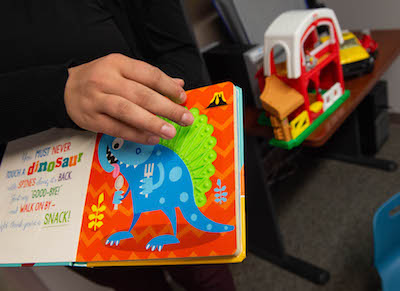Families will no longer have to wait two to three years to travel to Albuquerque in order to obtain an autism diagnosis for their children once a new autism diagnostic center opens its doors at the New Mexico State University Las Cruces campus.
 Alfred Valdez, interim head of the Department of Communication Disorders at New Mexico State University, discusses the new autism clinic that will be located alongside the Edgar R. Garrett Speech and Hearing Clinic, inside the Communication Sciences building on the NMSU campus. (NMSU photo by Josh Bachman)NMSU’s College of Education will be receiving $614,000 in recurring funds from the State of New Mexico, along with $107,000 in non-recurring funds, to open the clinic, which will initially be located alongside the Edgar R. Garrett Speech and Hearing Clinic inside the Communication Sciences building.
Alfred Valdez, interim head of the Department of Communication Disorders at New Mexico State University, discusses the new autism clinic that will be located alongside the Edgar R. Garrett Speech and Hearing Clinic, inside the Communication Sciences building on the NMSU campus. (NMSU photo by Josh Bachman)NMSU’s College of Education will be receiving $614,000 in recurring funds from the State of New Mexico, along with $107,000 in non-recurring funds, to open the clinic, which will initially be located alongside the Edgar R. Garrett Speech and Hearing Clinic inside the Communication Sciences building.
“We are a land grant institution serving the community, and we have so many children who need help,” said College of Education interim Dean Susan Brown. “The legislature has recognized that New Mexico needs a center in the southern part of the state in order to serve our families.”
Brown said the college will receive funding for the clinic beginning July 1.
Alfred Valdez, interim head of the Department of Communication Disorders, has spearheaded the project, working closely with State Sen. Mary Kay Papen and NMSU senior director of government affairs Ricardo Rel to secure funding. Valdez said he has also received assistance from the University of New Mexico’s Center for Development and Disability, which houses the state’s only autism diagnostic clinic and often has a waiting list two to three years long.
 Genevieve Muñoz, coordinator of clinical education at New Mexico State University’s Edgar R. Garrett Speech and Hearing Center, talks about the types of tools speech therapists use when diagnosing or working with a patient with autism. (NMSU photo by Josh Bachman)“Sen. Papen has been very supportive of this idea. It was a team approach,” Valdez said.
Genevieve Muñoz, coordinator of clinical education at New Mexico State University’s Edgar R. Garrett Speech and Hearing Center, talks about the types of tools speech therapists use when diagnosing or working with a patient with autism. (NMSU photo by Josh Bachman)“Sen. Papen has been very supportive of this idea. It was a team approach,” Valdez said.
In order for a child to receive treatment for autism, the child must have a diagnosis. There are several local autism treatment providers, and Valdez said that a two-year wait for a diagnosis could result in an increased cost for autism spectrum disorder intervention and a “less favorable outcome.”
“The quicker you can get treatment the better,” Valdez said. “If you don’t, then you’re at risk of developing associated issues. Some children show early signs of autism.”
Valdez said infants as young as six to 10 months typically demonstrate communication intentions.
“For example, infants will point to an object and then gaze at their caregiver as if they are asking the caregiver to share that experience,” Valdez said. “We call that behavior joint-attention or reciprocation. While we often see such behavior in typically developing infants, we seldom see such behavior in children diagnosed with autism.”
Valdez said there has been a rapid increase of autism spectrum disorders over the past two decades. According to the U.S. Center for Disease Control, community estimates of a positive autism spectrum disorder diagnosis as of April 2018 are as high as 13 for every 1,000 children aged 8. National estimates in 2014 showed an autism spectrum disorder incidence rate of 1 in 50, three times the estimate for the year 2000.
“It is critical to spread rather than centralize access to critical care services in this state,” Valdez said. “A second center established in Doña Ana County, the second most densely populated county in New Mexico, can help decentralize autism spectrum disorder diagnostic services and offer greater availability to services within New Mexico. Such a center would also offer more timely diagnosis and intervention for those with autism spectrum disorders and reduce the currently backlog.”
Brown said she hopes the autism clinic at NMSU will eventually be housed in O’Donnell Hall.